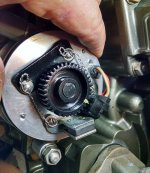Normally you have one p-mag and another ignition, p-mag, magneto, LSE... that kills your argument. Would you fly on one ignition, be it obe P-Mag or dual electrically dependent ignition on back-up battery only. No.
As far as flying a dual electrically dependent EI units, loss of both main and back up electrial power is possible. Rare bur possible.
Senerio above, having electrical issues, landing, having lunch, taking off again all on back up power is funny. Seriously you all who need a battery for engine to run, best make sure the main electric system (alternator, main battery) AND back-up battery are 100%. Seems obvious, but I have seen weird choices.
As pointed out above the backup electrical system, especially batteries, need to be tested (daily) and maintained. If your main battery is dead, I would never jump it and go fly, with the idea I have a 2nd battery. Best to recharge and check it. If EITHER main OR back-up batteties are weak, I wouldn't fly. I say this from experience of others. If your main battery is not starting engine well, investigate and replace, especially or dual EI that needs battery pwr.
Regarding P-MAG min RPM to run on internal power varies, 800 to 900 RPM, typical. The fixed pitch RV-9 runoff runway senerio, that is a stretch pun intended. I recomend not running off runway. May be land on longer runway, use those brake thingy stoppers. Ha ha. May be have on P-Mag and one regular Magneto? That is a very good setup. One EI is 70% of gain and 2nd EI 30% more.
How to do run up of P-MAG? See manual (on line pdf). It's same as magneto, run up RPM, L only, R only, with extra step of turning off external power to respective P-MAG you're checking, momentarily. Nothing happens, solid. I have pullable CB's for each P-Mag but switch can be used. They are wired separately from the main bus. It's all in the manual on Emag Air's website. It's detailed. ONCE a year or when ever you feel like it, you do a stress test. At 1200 RPM, running one P-Mag, you remove ships power from ignition and slowly lower RPM to find min RPM it will run. As stated 800 RPM is typical min RPM.





